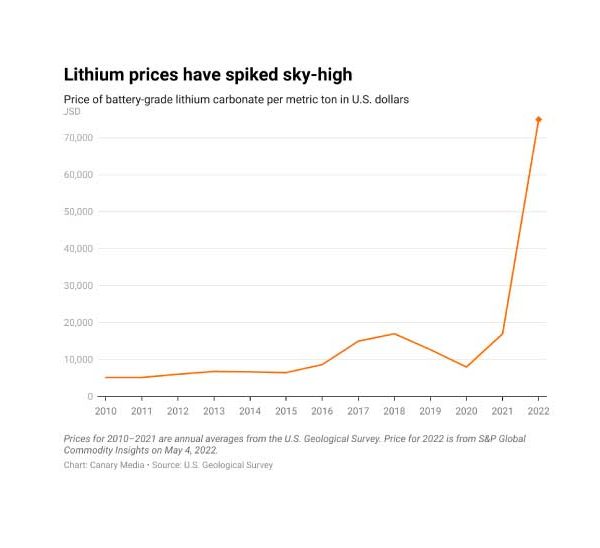CLEAN POWER & GREEN HYDROGEN
The Chicken And The Egg
Veteran cleantech journalist Amy Harder writes for Cipher, a newsletter from Bill Gates’ Breakthrough Energy Ventures. One of her articles caught our attention with its discussion of the symbiotic relationship between renewable sources of electricity and green hydrogen.

“To clean up our economy,” Harder writes, “experts agree we need to electrify as many parts of it as possible. In turn, that electricity needs to be powered by clean resources, like wind, solar and nuclear power, as fast as possible to make the biggest dent in heat-trapping emissions.”
Harder cites research from BloombergNEF suggesting this will require the world’s electricity capacity to increase anywhere between four and nearly eight times its current size. She also refers to a Princeton University study of potential electricity sources for heating and manufacturing, two sectors still largely powered by fossil fuels.
In a scenario that assumed large amounts of wind and solar electricity (a direction we seem to be headed), the Bloomberg study noted that “green” hydrogen made from electrolysis using wind and solar power proliferated. Hydrogen has the singular advantage that it is both clean-burning and portable, ideal for a diverse variety of energy applications, including storage, manufacturing, and long-haul transportation.
Up to now, the main factor that has hindered the greater adoption of wind and solar has been its intermittency. You only get power when the sun shines or the wind blows, and then sometimes you get too much. But, according to Jesse Jenkins, Princeton University professor and co-author of the study as quoted in Harder’s piece, demand from applications like those above has the potential to “suck up whatever extra wind and solar there is and [allow the use of] a lot more renewable electricity to displace industrial fuels than you would otherwise.”
For hydrogen production to be truly “green,” it needs to be produced by a clean process which is itself powered by clean electricity. Electrolysis is the dominant means of producing green hydrogen today, but it uses a large amount of electricity and needs to operate around the clock to be economical. Ask us why 247Solar technology is ideally suited to this purpose.
Giving credit where credit is due, the chicken-and-egg metaphor is not ours. Harder attributes it in her article to Raffi Garabedian, CEO of startup Electric Hydrogen Co. Read the full article here.
MINE POWER

“The problem is that renewable technologies are incredibly energy and metals intensive. We’re going to have a freakout as we try to change the world economy unless we develop a lot more mines.” – Robert Friedland. Credit: Henry Lazenby – Mining.com
Mining is Key to the Electric Everything Era
Speaking of the chicken and the egg, what about the relationship between the mining industry and the coming energy transformation? Much is made of the need for existing mines to abandon fossil fuels, convert to green energy and lower their carbon footprints. Less discussed is the crucial role mining must play in decarbonizing the rest of the global economy.
This role was dramatically described by Robert Friedland, executive chairman of Ivanhoe Mines, as reported by mining.com. Speaking at the recent Investing in Africa Mining Indaba in Cape Town South Africa, Friedland said, “the problem is that renewable technologies are incredibly energy and metals intensive. We’re going to have a freakout as we try to change the world economy unless we develop a lot more mines.”
Why is more mining so essential? “Solar and wind energy require between seven and 37 times more copper per unit of electrical energy produced than simply burning oil or having a nuclear power plant,” says Friedland. Some examples he cites:
- “The new giant windmills as tall as the Eiffel Tower – these are the next generation ones – they’re 12 megawatts each. That’s a lot of power per windmill. In the US, we will need 5.5 million tonnes of copper just in the next few years to put up these big General Electric windmills.”
- “By 2030, 20 million EV charging points will need 250% more copper. By 2040 passenger EVs will require 3.7 million tonnes more copper per year. In contrast, internal combustion engine-driven vehicles need only about 1 million tonnes of incremental copper.”
- “A single 1,000-pound electric vehicle battery requires 500,000 pounds of raw material. “So, to transition just the world’s passenger cars to electric, we have to mine more materials in the next 30 years that we mined throughout human history.”
Where will many of these mines be located? Friedland singles out Africa and the Arabian Shield as the venues where the world’s future-facing minerals and metals will be responsibly produced. That’s good news for both regions as well as for the renewables industry. Both regions will benefit from the attendant job creation and economic growth, and both have abundant sunlight – ideal for going green from the get-go.
Read the full article here.
LITHIUM IS NOT THE ANSWER
 Two articles caught our eye that highlight how lithium-ion batteries are likely only an interim technology in the clean energy revolution. First is the price of lithium. As reported by Canary Media, lithium prices have skyrocketed lately, and are unlikely to get cheaper anytime soon. While abundant, lithium is expensive to mine and is subject both to massive demand today and exponentially greater demand in the future (see to the right with respect to electric vehicles).
Two articles caught our eye that highlight how lithium-ion batteries are likely only an interim technology in the clean energy revolution. First is the price of lithium. As reported by Canary Media, lithium prices have skyrocketed lately, and are unlikely to get cheaper anytime soon. While abundant, lithium is expensive to mine and is subject both to massive demand today and exponentially greater demand in the future (see to the right with respect to electric vehicles).
The second was a piece in Energy Storage News describing how thermal runaway (read: fire) is a hazard that is rare but real. According to ESN, “Power company AES Corporation is investigating the cause of what has been described as a thermal runaway incident at a 10MW battery energy storage system (BESS) site it owns and operates in Chandler, Arizona. The fire at the Dorman battery storage facility, which provides energy to local utility Salt River Project (SRP), began on 18 April. The sprinkler system was deployed automatically and continued to spray water for several days to keep the temperature down, and was turned off on April 29.”
Both items point to the need for economical, environmentally benign, long-duration storage technologies – a need for which our HeatStorE™ heat battery offers a solution.
NEWS FROM 247SOLAR
Watch a presentation by 247Solar Board Member and VP Natalie Lorenz at Energy Storage Trends powered by 247 Solar, a webinar presented by the Alliance for Rural Electrification (ARE) as part of their ‘Innovation for Electrification’ (I4E) showcase series. Natalie’s topic: 24/7 Clean Power& Heat for Rural Jobs. You can also read a short post on the topic on our website.
Also, watch a panel discussion at AFSIA’s Storage Technologies E-Conference entitled Storage for C&I Users, featuring our Director of Business Development, Rod Lancaster.
FOLLOW & JOIN 247Solar
LinkedIn, Twitter, YouTube, Whatsapp
Contact: info@247solar.com